Visit Darmstadt Art Nouveau
This town is about 30 kilometers away in the south from
Frankfurt. The great
duke Ernst Ludwig founded in 1899 a colony of 7 artists. Its aim was to
present
to people a modern block integrating housing and work place. This block
is
located on the Mathildehöhe. The colony organised 4
exhibitions in Darmstadt in
1901, 1904, 1908 and 1914.
Headed by the architect J.M. Olbrich, the colony staff was
also compounded by
:
- Peter Behrens (painter and decorative artist and then architect),
- H. Christiansen (decorator),
- P. Huber (decorator),
- L. Habich (sculptor),
- R. Bosselt (visual artist),
- P. Bürck (decoration painter).
In 1904 arrived the ceramist Jakob J. Scharvogel,
in 1906 the glass blower Josef Emil Schneckendorf and in 1907 the book
craftsman Friedrich W. Kleukens.
In 1914, the group is headed by Albin Müller who
replaced Olbrich (dead in 1908). He is surrounded by Bernhard Hoetger
(majolica
craftsman), Ernst Riegel (goldsmith), Theodore Wende (goldsmith) et
Emanuel
Margold (pupil of Hoffmann).
Tips for a visit in Darmstadt
| 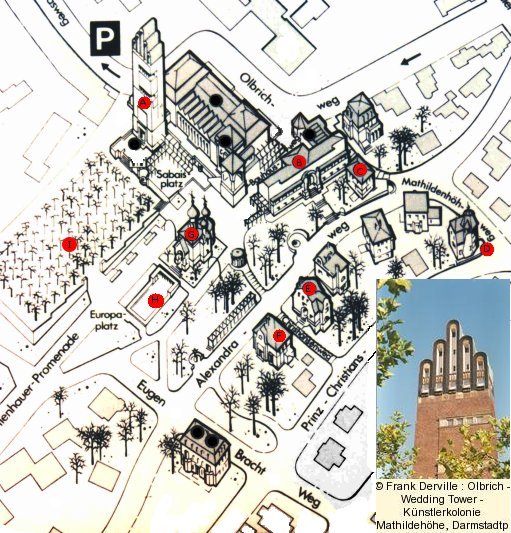
|
The Künsteler
Kolonie quater If you have
the opportunity to go to Darmstadt, visit the Artist Colony
(Künstlerkolonie) on the Mathildehöhe quater. It is
the place where most of the AN buildings are. It is small but the
quater was entirely designed by AN artists. There are still very few of
these Art Nouveau areas : Cogels Osylei in Antwerpen, Mers les
Bains in France...
This 3D map is displayed near the
entrance of the Museum Kunstler Kolonie. I have only modified the pins
to adapt it to the web and my Art Nouveau touristic view. |
| A | Wedding
Tower (Hochzeitsturm) : It is visitable but don't ( unless the wedding
room is open). The fare is expensive for a poor sightseeing. It is an
Art Nouveau fan trap. Just enter the hall and look at the mosaic. That
is all that you would pay for and it is not worth. This tower was a
wedding gift to the great duke from the town. The symbol is unity and
complementarity as the 5 fingers. |
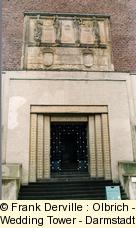
| 
|
| B |
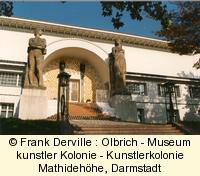
|

|
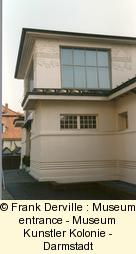
|
Museum Künstlerkolonie (Museum of the artist colony)
(originally called Ernst Ludwig House). It was built as a temple for
the Arts and has now been turned to a nice Art Nouveau museum. |
| 
|
| C |
House Olbrich by Joseph Maria Olbrich in
1901 : Olbrich was the leader of the artist group and he built most of
the houses of the colony. He is Austrian and the first part of his work
can be found in Austria and particularly Vienna.
In 1899, he built the Secession building in Vienna, one of the most
outstanding of Art Nouveau in this town. This type
of iron gate can be found in several villas in the
Mathildenhöhe. |
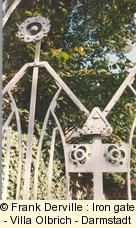
|

|
| D |

|
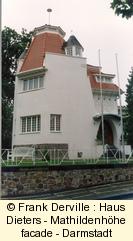 |
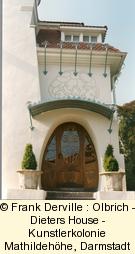
|
Hans Dieters House by Olbrich
in 1900: the most interesting Art Nouveau house in Darmstadt. It is now
an art gallery, so it can be visited : the stairway is worth a glimpse.
The main door is a jewel with its wooden flower sculpture to the bottom
and its stylized organic golden barrels
that annonce the design of the Wiener Werkstätte. |
| 
|
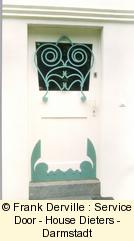 |
| E |
Grosses Haus Glückert (or Haus
Glückert I) by Olbrich in 1900. The door is very interesting,
reminding the one in house Dieters. The iron gate is also worth. |

|

|
| F |
Behrens House by Peter Behrens in 1901. As far as I know it
is the first building by Behrens who is now one of the most well known
German architect (after Gropius). At that time he was a paintor but he
designed every part of the house including spoons and forks! A true Art
Nouveau global masterpiece. Another great Art Nouveau
architects have started as paintor like Behrens : Henry Van de Velde.
| 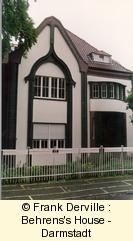
|

|
| G |
Russian church | 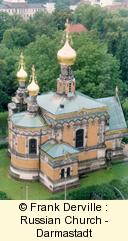
|
| H |
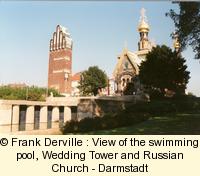
|
Swimming pool by Albin Müller.
There is a nice view over the russian church and the 48 meter wedding
tower. | 
|
| I |
The Platanen
wood hosts a statue (mother with child) and 4 reliefs : spring, sleep,
summer and resurection. |

|
| There
are also some other Art Nouveau/Jugendstil outside the
Künstler Kolonie. The most interesting building is the railway
station Visit also the Hessische Landes Museum. It
has a very good international collection of Art Nouveau objects.
(Tiffany, Van
de Velde, Behrens, Gallé,
...) | 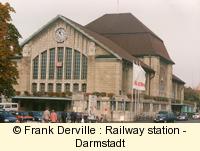
|

 RSS
RSS





















